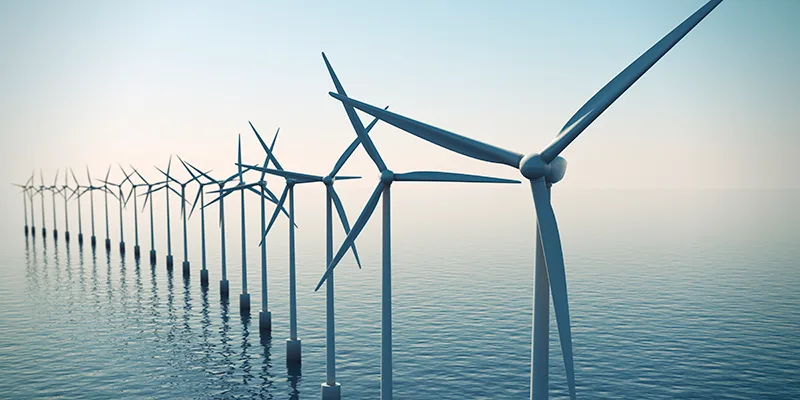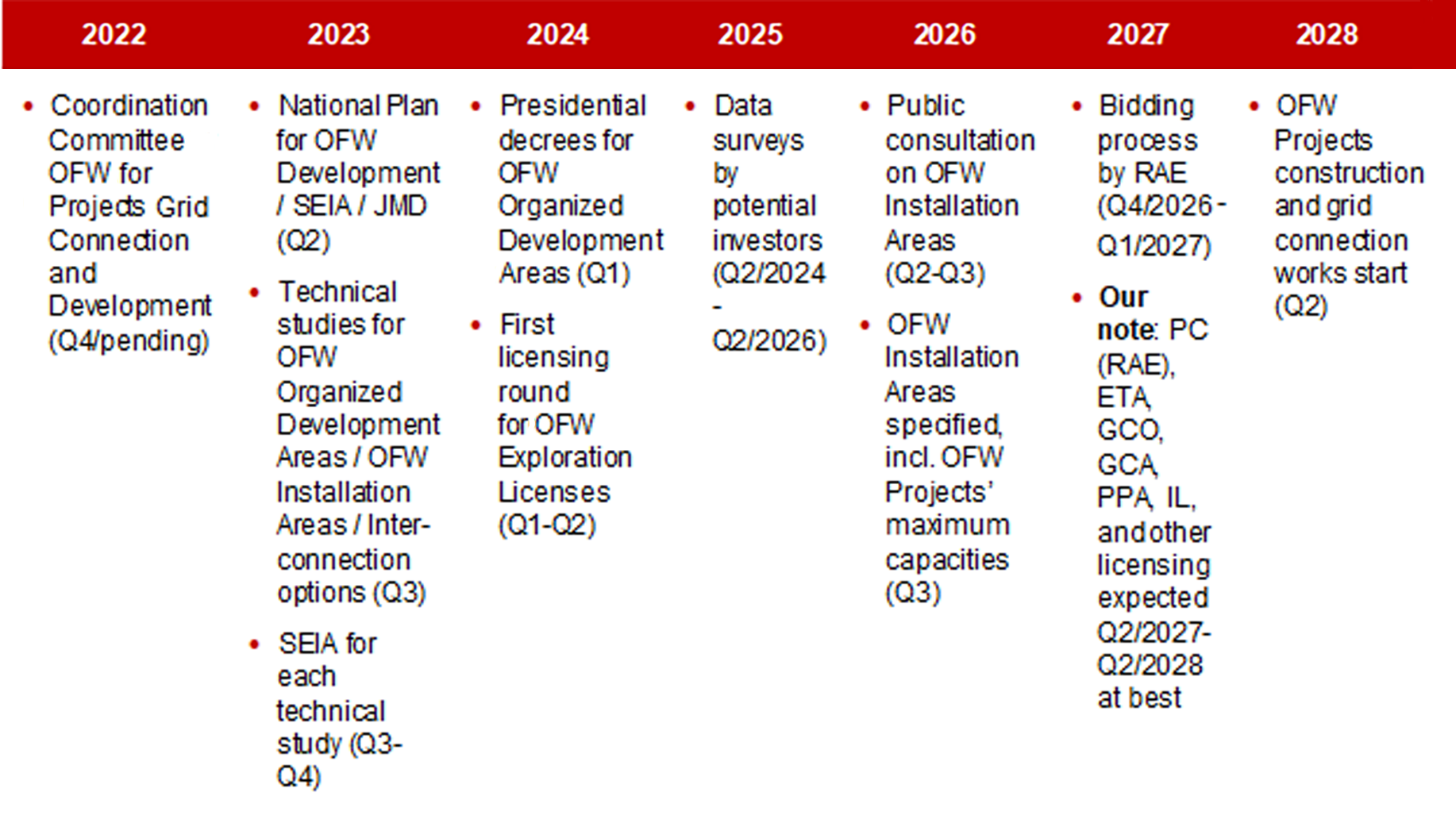Authors
Under the Hellenic Republic’s new offshore wind energy law, one state-controlled company, HEREMA, will propose and the government will decide which sea areas will be licensed to explore, develop and operate offshore wind projects in Greece, account taken of environmental, planning, national security and other matters of relevance.
The new law also sets requirements for applicants and rules for competitive bidding, so that renewable energy developers receive not only exclusive development rights in such areas but also operating aid for their projects, and thereby help Greece add 2.7 GW of offshore wind capacity by 2030, including 600 MW through a special pilot program in the Thracian Sea.
In July 2022, the Hellenic Parliament passed the long-awaited new law on the development of offshore wind projects in Greece, namely chapter H (articles 65 to 80) of Law 4964/2022 (the Law), which is aimed at establishing a coherent framework for the development, licensing, grid connection, and commercial operation of offshore wind projects in the Greek seas, in replacement of relevant past legislation that did not deliver any concrete results.1
Amid the energy crisis of 2022 and after a long period of discussions on the final market model, the Law was finally adopted with a clear objective to address the strong interest of international and domestic investors by defining the legal framework for the addition of a new, renewable energy technology in the power generation mix of Greece, a country enjoying one of the most significant, but still untapped, offshore renewable energy potential in the Mediterranean region. A national policy measure that is in complete agreement with the EU Strategy on Offshore Renewable Energy toward the achievement of the European Green Deal energy and climate goals for the period up to 2050.
In this context, we have set forth below a summary of the main provisions of the Law (including the main procedural steps of the framework) together with an update on the current state of play in terms of the rather limited progress made so far and the estimated time line regarding the adoption of several derivative legislative acts enabling the full implementation of the Law.
OFW Development Areas
The Law appoints the state-controlled Hellenic Hydrocarbons and Energy Resources Management Company (HEREMA) as the competent body for exercising the Greek state’s exclusive rights for the exploration and exploitation of the offshore wind potential within the country’s sea areas. In this respect, HEREMA is responsible for the preparation of a national plan for the development of the offshore wind technology (the OFW National Plan) on the basis of a technical study that shall take into account the main criteria set forth in the Law for the development of offshore wind projects, such as the National Energy and Climate Plan (NECP); the protection of the environment; spatial and maritime planning aspects; national security; and other relevant aspects or criteria like antiquities, monuments, infrastructures and other productive or development activities. The plan will be subject to Strategic Environmental Impact Assessment (SEIA) at national level and will also define the potential broader sea areas for the development of offshore wind projects (OFW Organized Development Areas), as well as the estimated project capacities to be developed therein. Once finalized, the plan must be approved by a joint decision of the Ministers of Environment and Energy; Finance; Development and Investments; Foreign Affairs; National Defense; Culture; Maritime Affairs; Rural Development; and Tourism (JMD). [Step 1]
As a second step, HEREMA shall prepare technical studies for the designation of specific OFW Organized Development Areas and the terms for the development of offshore wind projects therein, account taken of the aforesaid National Plan. Following SEIA process for every technical study at local level, the OFW Organized Development Areas will have to be approved by virtue of individual presidential decrees, initially for the period until 2030 and subsequently for the period beyond 2030, including the determination of the maximum project capacities to be installed in any such area. [Step 2]
OFW Exploration Licenses
Within two months from the publication of the presidential decrees designating each OFW Organized Development Area, HEREMA shall issue a decision defining the period within which any interested party is entitled to apply (electronically) for an OFW Exploration License for the development of a project within one or more designated development areas. Each licensing round shall last two months. New licensing rounds may commence after six months from the end of the previous one. [Step 3]
Eligible applicants for an OFW Exploration License from HEREMA are EU citizens or legal persons established in an EU member state or in a third country that has concluded multilateral international agreements or a bilateral international agreement with the EU in the field of renewable energy sources providing for mutual market opening including the licensing of offshore wind projects.
However, an applicant must also satisfy some minimum technical and financial criteria which comprise: (a) owned or borrowed experience during the last 10 years in the development of offshore wind projects, including at least the development of one 100 MW offshore wind project and experience in the operation and maintenance of projects in excess of 25 MW; (b) an annual turnover of the applicant or its shareholders and any related parties in excess of €2 million for at least one year within the last three years and an equity-to-debt ratio greater than 20 percent. In case of equity or other funds, total funds under management may be taken into account instead; and (c) letter(s) of guarantee(s) (in total) amounting to €10,000 per MW applied.
Further, an applicant must pay a one-off administrative fee of €10,000 (for each application), and it must be solvent and not subject to any exclusion grounds provided for by article 39 of Law 4413/2016 (effectively article 38 of Directive 2014/23/EU on the award of concession contracts). Moreover, an applicant must indicate their areas of interest for exploration, the identities of their shareholders or partners up to the UBO level – unless it is a listed company or an investment or an equity fund – and, of course, they must submit evidence in relation to the above, as these criteria will be elaborated upon by HEREMA in order for the application to be complete and admissible with due regard to national security, public health, and safety issues.
An OFW Exploration License is issued or rejected within 30 days from the filing of a complete application, while legal means of challenge are available in either case (first before HEREMA itself and by appeal before the competent administrative courts of Athens). The OFW Exploration License is not transferrable, and it is valid for three years.
However, OFW Exploration Licenses do not entail or grant exclusive exploration rights in the areas concerned, but they are a precondition for the installation of offshore wind projects in any such areas, provided they are successful in the following competitive bidding process for the award of operating aid under the national support scheme for renewable electricity according to Law 4414/2016. Only then will a developer be granted the exclusive rights for the licensing, development, and exploitation of a specific project in a specific OFW Installation Area.
Competitive bidding for operating aid and OFW Installation Areas
Within two years from the end of the first licensing round for the granting of OFW Exploration Licenses, HEREMA shall conduct a public consultation process for the delimitation of specific OFW Installation Areas within each OFW Organized Development Area. [Step 4]
Within two months from the end of the aforesaid public consultation process, the Minister of Environment and Energy shall issue a decision setting forth the specific OFW Installation Areas located within the broader OFW Organized Development Areas (for which OFW Exploration Licenses have already been granted) as well as the total capacity that can be installed therein. [Step 5]
Within four months from the issuance of the above ministerial decision (and following another ministerial decision on the competitive bidding process framework for offshore wind energy capacity in particular according to the Law and state aid clearance from the European Commission) the Regulatory Authority for Energy (RAE) shall launch a competitive bidding process for the granting of operating aid to projects that may be developed within the aforesaid (specific) OFW Installation Areas, including details about tender participation and assessment criteria, required guarantees, performance penalties, and other aspects of the tender. [Step 6]
Eligible participants to such competitive bidding process, however, shall be only holders of OFW Exploration Licenses. The selection criterion for the granting of such operating aid and related exclusive rights is the lowest bid expressed in euros per MWh (€/MWh) for the power to be produced from the successful project in a specific OFW Installation Area (OFW Investor).
Accordingly, the OFW Investor shall enter into a standard (regulated) Sliding Feed-in-Premium Operating Aid Agreement with the RES & GO Operator in Greece (DAPEEP S.A.) in accordance with articles 3, 6, and 9 of Law 4414/2016 on the basis of the Reference Price that will derive from the competitive bidding process for the successful OFW Project in a specific OFW Installation Area. [FiP PPA]
The Sliding Feed-in-Premium Operating Aid Agreement (also known as FiP PPA) is valid for 20 years (starting from the issuance date of the respective Operation License according to article 28 of Law 4951/2022), and it is effectively a two-way contract for differences account taken of the energy market revenues of the renewable electricity producer from such a project through its participation in the Day Ahead Market (DAM) operated by HENEX S.A., adjusted for (meaning reduced by) any other form and amount of investment aid it may receive under any other support scheme for investment projects.
Licensing and development
Following the above tender, the OFW Investor shall submit to RAE an application for a Special Projects Producer’s Certificate pursuant to article 11 of Law 4685/2020 and the relevant Certificates Regulation of December 2020. [Step 7]
The Special Projects Producer’s Certificate is issued within three months. It is valid for up to 30 years, and it is renewable for up to the same period. OFW Investors must then proceed with the application for the respective project’s Environmental Terms Approval (ETA) within 12 months (extendable by another 24 months in case the project is developed in a Natura 2000 area where a Special Ecological Assessment (SEA) is required in addition to the standard Environmental Impact Assessment (EIA)) [Step 8] and for the granting of a Grid Connection Offer (GCO) within 72 months from the issuance date of the Special Projects Producer’s Certificate, respectively, as otherwise the said certificate becomes invalid, as per article 12 of Law 4685/2020. [Step 9]
Moreover, OFW Investors must in general comply with the rest deadlines set by the applicable legislation for the implementation of renewable energy projects like the ones set forth in article 31 of Law 4951/2022, but paragraph 7 thereof explicitly excludes any such projects which have been selected for receiving operating aid through a competitive bidding process. In such cases, the ministerial decisions authorizing the relevant tenders prevail in relation to project implementation deadlines. Therefore, offshore wind projects would also be excluded from the scope of the said article. However, these projects typically fall under the scope of articles 17, 19, and 20 of Law 4951/2022 regarding their Installation Licenses following their Special Projects Producer’s Certificate, ETA, and GCO issuance; and chapter E (articles 25-30) of Law 4951/2022 regarding their Operation Licenses following construction and commissioning, including energization and the start of trial/commercial operation.
Interconnection with the high voltage grid (System)
More specifically regarding grid connection aspects, following the issuance of the ETA, an OFW Investor must submit to the Independent Power Transmission System Operator (IPTO), which is solely responsible for the design, development, construction, and operation of the required interconnection works from the backbone, high-voltage transmission grid (System) up to a nodal / interconnection point in each OFW Organised Development Area, a complete application for the granting of a GCO accompanied by an interconnection study of the project with the System and of course the project’s ETA. [Step 10]
Each OFW Investor shall bear the cost for the implementation of the works for the connection of its project up to the interconnection point of the OFW Organised Development Area to be built by the IPTO, on the basis of the terms to be specified in the relevant GCO. Apparently, IPTO’s role is expected to be pivotal in developing and constructing such nodal points and hubs in sea areas for the connection of the subject projects to the System. This development will be rolled out in parallel with the IPTO’s current investment plan for the interconnection of most Aegean Sea islands by the end of this decade.
Without prejudice to the applicable grid priority regime for renewable energy projects set forth by Article 89 of Law 4951/2022 and relevant ministerial decisions, IPTO shall issue the GCO within two months from the submission of a complete application for the issuance of the GCO. Τhe OFW Investor must accept (or reject) the GCO within two months and (in the affirmative) submit to IPTO the relevant grid connection bond, presumably for an amount to be calculated according to Article 6.3 of Law 4951/2022 although the Law is not very clear about this bond. [Step 11]
Subsequently, the IPTO and the OFW Investor shall enter into a Grid Connection Agreement (GCA) specifying in more detail their respective rights and obligations. The GCO remains in force until the issuance of the Installation License and the signing of the GCA when the said grid connection bond is to be returned to the OFW Investor (by derogation to the general rule applying to all other renewable energy technologies that such grid bonds are decreased to one fourth their initial amount when the relevant GCA comes into effect). [Step 12]
Other provisions of interest for offshore wind
The Law provides for a Special OFW Duty equal to 2 percent of a project’s revenues from the sale of electricity (before VAT), which shall not be less than two euros per MWh and which shall be due from the start of a project’s trial operation until the end of its operation.
Furthermore, a Coordination Committee for the Grid Connection and Development of offshore wind projects will be established shortly in order to support HEREMA in defining maximum project capacities, optimum grid interconnection options, and time lines, including in relation to non-interconnected islands and other large-scale or international interconnections like the EuroAsia Interconnector between Israel, Cyprus, and Greece, and in general facilitate its cooperation with the Ministry of Environment and Energy, IPTO, RAE, and other competent bodies for the development of such projects.
The submission of new applications for the issuance of Special Projects Producer’s Certificates for offshore wind projects is suspended, unless they have been selected through the competitive bidding procedure described herein above. The letter of guarantee required for the issuance of a Special Projects Producer’s Certificate, as per article 11A of Law 4685/2020, is not applicable to offshore wind projects participating in such competitive bidding process.
Moreover, article 14 of Law 2971/2001 on seashore and sea areas has been modified in order to include special provisions for simplified procedure regarding the direct concession upon application but still without consideration for the use of the seashore, beach, seabed, and sea areas for the installation of meteorological masts (either fixed or floating) for the recording and measuring of climatic conditions and, in particular, offshore wind potential. Environmental clearance or exemption thereof is still required, including in relation to any auxiliary installations.
Chasing the offshore wind against the clock…
The CEO of HEREMA recently presented an implementation time line during a workshop titled “Offshore Wind Energy in Greece: The way forward” which was jointly organized by the Hellenic Wind Energy Association, Grant Thornton (Greece), and HEREMA on December 12, 2022.
The road map speaks for itself about the challenges ahead of such a multitask exercise and deliverables from HEREMA and other competent bodies involved in order for the works for the construction of the first projects to commence sometime in 2028 and actually come online by 2030, according to the National Energy and Climate Plan (NECP). The NECP is currently under review, and now, in the revised version that was presented a few weeks ago, it envisages the addition of 2.7 GW of offshore wind capacity by 2030 and 17 GW by 2050.
A special pilot program
By exception to the above framework but still largely in the same context, article 174 of the Law provides for a special pilot program for the development of offshore wind projects up to 600 MW to be developed in the Thracian Sea, once a relevant presidential decree (following SEIA) designates the subject area as an OFW Organized Development Area and, accordingly, specifies OFW Installation Areas and maximum project capacities that cannot be less than 200 MW. [Step 1]
This pilot program solely concerns holders of existing Electricity Production Licenses or Special Projects Producer’s Certificates (or pending ones applied for under the previously applicable regime) for offshore wind projects that are located in part or in whole within the aforesaid development area. The license holders (or the applicants) may apply with RAE within two months from the issue of the above presidential decree in order to update or revise their existing licenses and/or pending applications regarding their proposed projects, account taken of some provisions set forth therein regarding minimum distances between offshore wind turbines. They must also submit a letter of guarantee per article 11A of Law 4685/2020 for an amount equal to €100,000 per MW in order for the updated, revised, or new Producer’s Certificates in question to be issued for an initial term of 30 years and the implementation deadlines of article 12 of Law 4685/2020 to begin counting. [Step 2]
Accordingly, the license holders will be considered as OFW Investors with exclusive development rights in their respective areas while they may be entitled to receive operating aid under a 20-year FiP PPA with a regulated Reference Price outside the scope of the competitive bidding process described herein above, subject to prior state aid/individual aid approval from the European Commission according to the applicable EU state aid regulations and guidelines on state aid for climate, environmental protection, and energy. [Step 3]
Relevant ministerial decision will define the exact time line for the licensing, development, and implementation/start of operation for the subject projects, but still within six years from the aforesaid approval of the European Commission. Environmental and other licensing at project level, including GCO and GCA aspects, will follow the generally applicable legislation, but will extend automatically until the end of the aforementioned six-year period. [Step 4]
Failing to meet the timeline shall result in their licenses, permits, and approvals becoming invalid automatically, while failing to obtain such individual aid approval, the subject OFW Investors are obliged to participate in the competitive bidding process to be launched as described above. Failure to do so can result in their Producer’s Certificates becoming invalid.
This option in effect concerns an existing license for an offshore wind project of 216 MW held by Thrakiki Wind 1 S.A. of Copelouzos Group since 2012, and a pending application for an offshore wind project of circa 585 MW filed by a Terna Energy S.A. subsidiary in 2007, while both of these projects are found offshore the port of Alexandroupolis.
Concluding remarks
The pilot program intends to reconcile the new centralized system of the Law for identifying suitable areas for the licensing and development of offshore wind projects with the past de-centralized system, which was largely at investors’ initiative subject to any exclusion zones under the applicable environmental and spatial planning legislation, including the special spatial planning framework for renewables of December 2008, which is pending review and an update. It is likely, however, that the pilot program may yield results ahead of the normal course of the Law.
On the other hand the National Plan and the presidential decrees approach for identifying suitable areas for the purposes of the Law (including the pilot program area) is clearly aimed at expediting the process while pending not only the revised special spatial planning framework for renewables but also a national maritime spatial plan under EU Directive 2014/89 and Law 4546/2018. However, presidential decrees take time to be issued following SEIA and prior review and opinion by the Council of the State (Supreme Administrative Court of Greece) on legal matters and aspects thereof. Hopefully, the pending spatial plannings will not raise any controversies regarding the subject matters.
Besides the challenging timeline for the full implementation of the Law vis-à-vis the country’s target for the addition of a significant offshore wind capacity by 2030, another issue that has raised concerns from some investors is the rather arguable approach taken by the Law as to the late timing of the exclusivity rights granted to an OFW Investor in a specific OFW Installation Area within the framework of the overall process. Apparently, this is an issue that is expected to be adressed and clarified in the anticipated enabling secondary legislation in order to provide adequate comfort to the developers who are called to invest significant amounts during the exploration phase.
Last but not least, the steepening seabed morphology of the Aegean Sea in conjunction with the territorial sea of Greece in the Aegean Sea (where offshore wind potential is very significant), which currently extends to six nautical miles while pending the delimitation of an Exclusive Economic Area therein may also limit the available suitable areas for either fixed-bottom or floating projects.
Only time will prove the adequacy of the Law, but the proven commitment of the Greek government and HEREMA to implement the Law and achieve the objectives and the targets of the NECP by 2030 and beyond cannot be disregarded. Potential investors’ willingness for investments in such a high potentials area for offshore wind like the broader Aegean Sea is a given in view of their current positioning and recent joint ventures between major national and international market players.
- For more information on the previous legislative framework and the various issues raised during the making of the new Law, please refer to our briefing of April 2021, “Unlocking Greece's offshore wind”.
In-depth 2023-038




